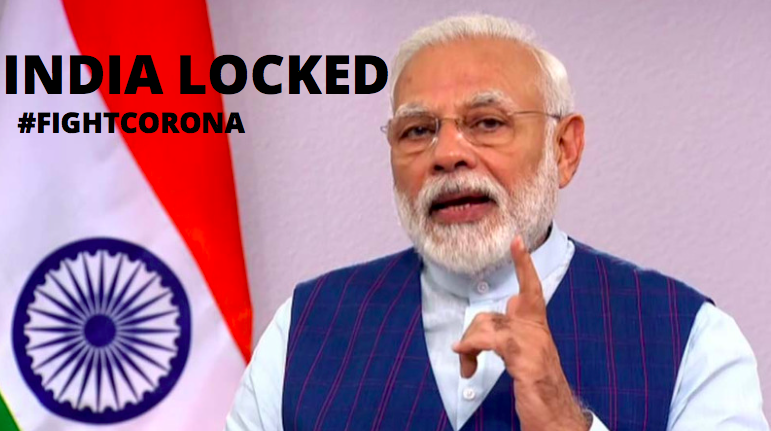AsiaTechDaily – Asia's Leading Tech and Startup Media Platform

The Biggest Lockdown Ever – India Locks Up A Billion People In Its Fight Against COVID-19
India, the world’s second-most populous country, is making aggressive efforts to contain the spread of the novel coronavirus. With 562 confirmed cases including ten deaths (at the time of writing this article) and counting, Prime Minister, Mr. Narendra Modi, announced the biggest lockdown ever on 24th March 2020 in the fight against COVID-19. For the next 21 days, there will be restrictions on all commercial and economic activities across the length and breadth of the country.
In the wake of the coronavirus outbreak, countries across the world are taking unprecedented measures to grapple with this pandemic. India put its 1.3 billion citizens under complete lockdown to ensure that they do not inch faster towards stage 3 of this epidemic. Although a few cases are being reported where people infected with this disease do not have direct travel history. Therefore, this was the ‘best step’ India could take to keep a check on the community spread.
Why India needed a complete lockdown?
Some of the most developed countries in the Western world with advanced healthcare infrastructure are struggling to contain the spread of this deadly disease. As per reports, the worst affected countries of Europe – Italy, and Spain are even forced to make a choice to treat patients with the best survival chances. Even the United States, with all its might, is struggling to contain the disease due to poor planning and stressed healthcare infrastructure. As per a recent report, President Donald Trump requested South Korean president Moon Jae-in for coronavirus testing materials amidst an exponential surge of positive cases in the United States.
In the middle of all this, India finds itself in a perilous situation where if the virus spread is not contained now, it may create havoc in a developing country like India, which spends just 3.66 percent of its GDP on healthcare. India has a population density of 420 people per square kilometer, and in the financial capital Mumbai, it’s an astonishing 21,000 people per square kilometer. Social distancing and self-quarantine in India are tough with such a high population density.
A government report estimated that nearly 29.4 percent of the country’s urban population lives in slums. Such housing setup does not even have the basic amenities, and people queue up in front of public taps even for their water needs. A virus outbreak in such neighborhoods can be disastrous.
The Prime Minister in his televised address acknowledged that a complete lockdown is necessary; otherwise, healthcare infrastructure would crumble.
During this lockdown period, all international, domestic flights stand canceled, trains, metros, and all interstate bus services have been stopped. Most of the private and commercial establishments will remain closed. However, essential services such as grocery stores, gas stations, banks and ATMs, and online goods delivery will be allowed.
With limited testing facilities, there could be a possibility that the virus may be spreading undetected. Just 15,000 tests have been conducted for more than a billion people compared to South Korea, where well over 300,000 people out of its 52 million population have been tested.
According to the Prime Minister, the country will have to pay a heavy economic price due to this lockdown; however, saving the lives of people is of paramount importance.
The ripple effect of this three-week lockdown on the Indian economy
The first round of impact on India was seen in January 2020, when the virus was spreading in China at a fast pace. Many companies, due to their over-dependence on Chinese imports, saw supply-side disruptions.
As the virus spreads across the country, economic activities have slowed down as many cities announced lockdowns. Now the country is witnessing a nation-wide lockdown as the Central and State Governments are working in tandem to fight against Covid-19.
A host of companies like BHEL, India Cements, Maruti Suzuki, Renault, Hyundai, Hero MotoCorp, and M&M have announced complete shutdowns. The FMCG firms such as ITC, Hindustan Lever, and Dabur India have also closed their manufacturing facilities except for the plants that produce essential commodities, just after the partial lockdown was announced in some parts of the country. It is also being said that the aviation and hospitality industry will face their worst ever slow-down.
Morgan Stanley, since the outbreak, has cut India Inc’s earnings for the third time. Barclays claims that this aggregate shutdown may cost around 4% of GDP or $120 billion. They also said that most likely, Reserve Bank of India will go for a 0.65% rate cut in April review and will cut interest rates further by 1% during the year.
Experts suggest that the unorganized sector will be pushed to the brink as they are already reeling under the impact of demonetization and GST (goods and services tax). From taxi and auto drivers to street vendors will bear a grave impact of this lockdown since their survival depends on daily cash flows.
Besides that, a large chunk of India’s workforce doesn’t have a steady source of income or are daily wagers, and that section will be severely affected. Although the central & state governments are planning to roll out relief measures, however, the complete details are still not known.
India and the world fights Corona
In this ever-changing fluidic situation where things are changing every minute, the battle will be long, and effects will be lasting. Due to the present situation, India may have to face a volatile economic situation. Even if the country manages to avoid the surge in infection cases, the livelihoods of many will be affected.
All we can do is just wait and watch and see how the situation evolves.
Stay tuned with latest WHO updates. Stay safe!





